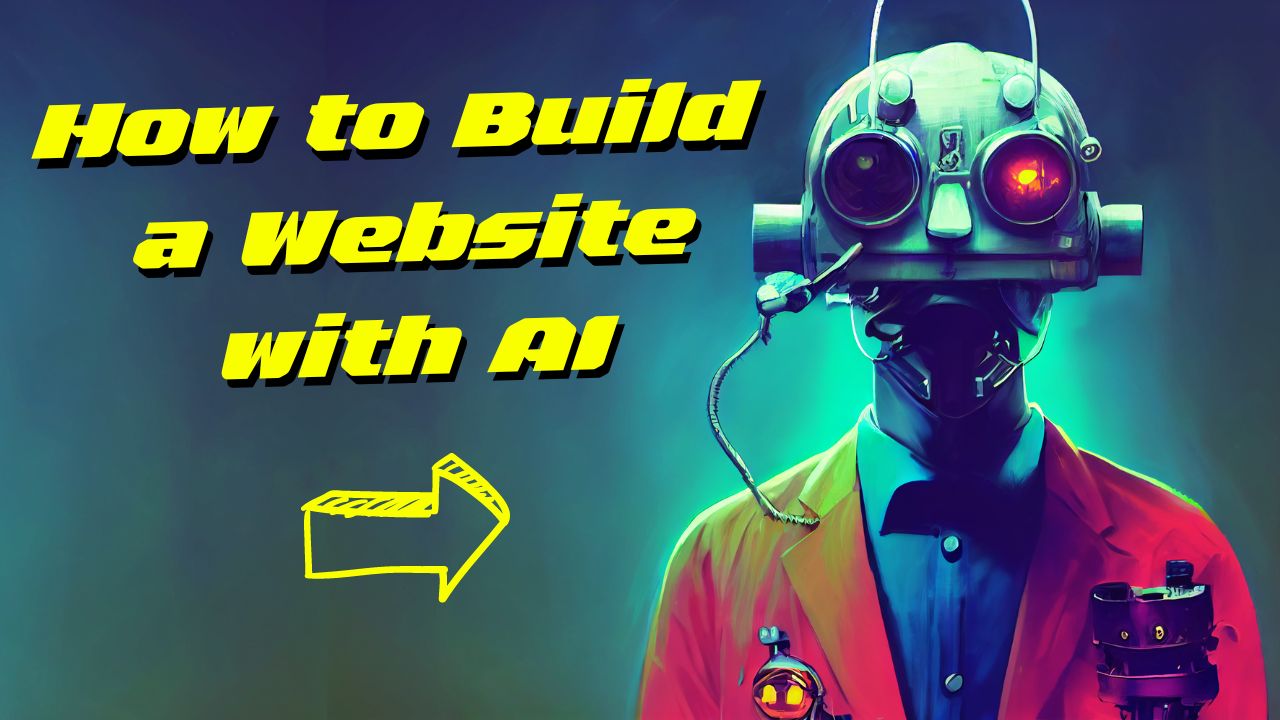Generative AI is no longer a futuristic concept; it is increasingly becoming a part of our everyday lives.
From the way we search for information online to the ads we see, AI is changing the way we live and interact with the world around us.
Now, AI is also changing the way we build websites. Using Generative AI to generate content and create images for your website can save you time and money, and it can also help you create a website that is truly unique.
In this post, we will show you how to build a website with Generative AI, using the GPT-3 large language model to generate content and Stable Diffusion to create images. We will also provide some tips on how to market and monetize your website.
Read more, or watch the YouTube video
YouTube:
How to Build a Website with Generative AI
Pick Your Topic
This is of course the first step you do when you are planning out a new website. With the new GPT-3 text-davinci-003 model that is much for creative you can get even better results at the same price.
In this example the main topic we have chosen is: “Artificial General Intelligence”.
Most of your content will be based around this, but we also want related topic for search engine optimization (SEO).
Find semantically related topics with GPT-3
For your content to rank and get organic traffic from Google or other search engines, we really want to write about semantically related topics to our main topic.
So in this case our topic is “Artificial General Intelligence”, we want to ask GPT-3 for semantically related topics to that.
In GPT-3 we use the prompt:
You are an expert Google Search SEO with all the knowledge of the Google Search Algorithm.
What does Google search think is semantically related topics to the topic “Artificial General Intelligence”:
In this case we get back:
- Deep Learning
- Natural language processing (NLP)
- Machine learning
Now we have our main topic and 3 other semantically related topics for our website.

GPT-3 Image Suggestions
Here you should concider watching my tutorial on how to use the Dall-E 2 API to create AI Art.
With our 4 topics ready, we could use GPT-3 to give us suggestions for images to create in Stable Diffusion or Midjourney.
To get some good suggestions i just use the prompt:
“Give me 5 examples of great images for a Website from our 4 topics:”
This should give you some thematically related images to your topics.
Translate to Midjoruney / SD prompts
Next step we just use your GPT-3 suggestions and translate them into great prompts to use in Stable Diffusion or Midjourney. One example of this could be:
Augmented Reality, Cyberpunk, Hyperdetailed, 2d artwork, fantasy, Orphism, Magic, Stylize, contrast, darkness, emotion, Concept art, Mandy Jurgens, intricate detail, Digital painting, Jojos bizarre adventure, Zack snyder, Yasar vurdem, Christopher Moeller –ar 4:3 –test
Here “Augmented Reality” was the suggestion from GPT-3, rest of the prompt was my choice.
Domain and Host
Every website will of course need a domain and a host. This is pretty standard, and I will go into details about this in this post. So if you want more information about this watch the YouTube video.
Domain and Host suggestion:
- Godaddy.com for domains
- Cloudways for “pay as you go” hosting
WordPress website
I personally always go for a WordPress website where I will have almost full autonomy over the website. But you could of course go for website builders like Sqaurespace and WIX.
Generative AI Content Creation with GPT-3 and Python
To create our content for the website we will use a combination of GPT-3, a Python script and human rewriting.
GPT-3 AI Content
To write content with GPT-3 I use an open source script from David Shapiro. I am not gonna go into specific details about how this works here. But check you Davis YouTube channel here for more info:
David Shapiro YT: https://www.youtube.com/c/DavidShapiroAutomator
The Python script lets us just put in the prompt what we GPT-3 to write about, one example of this can be:
I want a blog post about Machine learning. I’d like to know what Machine learning is, its history and what it is used for.
By running this prompt in the script we get back a 1500 word post about Machine Learning in a semi unstructured text file.
Prep content for publish
Here I prefer a human to read and organize the text and add in H2 headlines. With GPT-3 content creation errors and non-true information can occur. So it is always very important to fact check your content before publishing.
Check the YouTube video for the final result of the Machine Learning post.
Image Creation with Stable Diffusion from GPT-3 prompts
Now that we have our content ready to publish, we want some images for our posts. Running the GPT-3 prompts in AI art generators like Stable Diffusion or Midjourney can provide us with license free images all day long.
Run your prompts and pick out the ones you like the most. Then we are ready to publish our content on the website with AI generated images to go with the text.
Website Setup
I am not gonna explain in detail how you set up a wordpress website with hosting from Cloudways in this article. But here are some links to great tutorials how you can do this:
WordPress: https://www.youtube.com/watch?v=oX3lgJoj27g
Cloudways: https://support.cloudways.com/en/articles/4805075-how-do-i-take-my-website-live-from-cloudways
Generative AI Content Deployment
Now we should have our content ready to deploy to our website. Since these four Generative AI generated pieces of content is our main topic and 3 semantically related topics, i also want this to be our categories:
- Artificial General Intelligence
- Deep Learning
- Natural Language Processing (NLP)
- Machine Learning
We will now of course publish each post under their matching categories.
Image Integration
After we have deployed our content into 4 posts, we want to integrate at least 3 images per post. I recommend converting the AI generated images from Stable Diffusion or Midjoruney to jpg files to improve Core Web Vitals like page loading speed.

Publishing and SEO
With all the AI generated content deployed and images integrated, we are now ready to publish.
Since our website is now set up into 4 different topics, I don’t want to interlink between these pages at the moment.
I`ll rather focus on building out supporting articles for each topic to improve our SEO. One example of this could be:
Topic: Deep Learning
Supporting article: Why is deep learning used?
Now build an internal link from the supporting article to the main topic post.
Repeating this and building out your silo with more internal links should really improve your SEO and organic traffic.
You should now be ready to hit publish on your website.
Website Marketing with GPT-3
Now that we have published our website, the job is not over. All new websites need some kind of marketing to get going. Using Generative AI tools like GPT-3 or GPT-4 is the future of digital marketing.
Since GPT-3 has read a lot about marketing from its data training set, it should be able to help us come up with some good marketing tips.
So i have constructed this prompt to ask GPT-3 for marketing tips:
You are an expert in digital marketing and launching new websites. I have a new website ready for launch. Can you give me 5 great marketing tips?

5 GPT-3 Marketing Tips
Lets look at 5 digital marketing tips from GPT-3:
1. Plan your marketing strategy and budget in advance. Pre-launch marketing activities should create excitement and anticipation for your website launch.
2. Develop a strong social media presence. Create accounts on all the major social networks and start building a following before you launch your website.
3. Write a compelling copy. Your website copy should be clear, concise, and persuasive. It should also be keyword-rich to help you rank high in search engines.
4. Create interesting and shareable content. In addition to your website copy, create blog posts, infographics, videos, and other types of content that will get people talking about your website.
5. Make sure your website is search engine friendly. Optimize your website for the major search engines so that people can easily find it when they’re looking for what you offer.
Monetizing your Website
Since we might want to make some money from our content, i create this prompt to get some advice from GPT-3 about monetizing:
You are an expert in digital marketing and launching new websites. I have a new website ready for launch. Can you give me 5 ways to monetize my website?
5 GPT-3 Website Monetization Tips
1. Advertisements – One of the most common ways to monetize a website is to display ads. Advertisers will pay you to display their ads on your website, and you will earn revenue based on the number of impressions or clicks that their ads receive.
2. Affiliate Marketing – Affiliate marketing is another popular way to monetize a website. With this method, you will earn commission on sales that are generated from visitors who click on links to products or services that you recommend on your website.
3. Sponsored Content – Another way to monetize your website is through sponsored content. With this method, businesses will pay you to create and publish content that promotes their products or services.
4. Sell Products or Services – If you have a product or service to sell, you can use your website as a platform to sell it. This can be an effective way to monetize your website if you have a niche audience that is interested in what you have to offer.
5. Offer Consulting or Expertise – Finally, another way to monetize your website is to offer your consulting or expert services. If you have expertise in a particular area, you can offer your services to businesses or individuals who need help in that area.

Conclusion
Building a website with Generative AI can save you time and money, and it can also help you create a website that is truly unique.
With GPT-3, you can generate content and create images for your website, and with Stable Diffusion, you can create license free images. Setting up a wordpress website is easy and Cloudways provides pay as you go hosting.
To market your new website, plan your marketing strategy in advance, develop a strong social media presence, and create interesting and shareable content.
You can monetize your website and start making money online by displaying ads, affiliate marketing, sponsored content, selling products or services, or offering consulting or expert services.
Overall, this is a great guide on how to build a website with Generative AI. It covers all the important aspects, from choosing a topic, to creating content, to setting up your website, to marketing your website.
It also provides some great tips on how to monetize your website.



It’s possible for you show the content of all prompt *.txt files?
I guess i could send you a .txt file?
I would really appreciate it
Send me an e-mail. You can find the adress on YouTube
Wow. Amazing.
Thnx 🙂